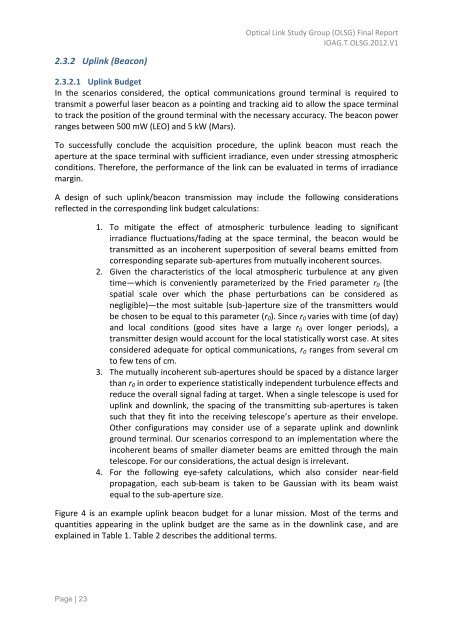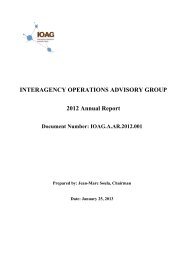OLSG Report_Final_06_05_12 - Interagency Operations Advisory ...
OLSG Report_Final_06_05_12 - Interagency Operations Advisory ...
OLSG Report_Final_06_05_12 - Interagency Operations Advisory ...
Create successful ePaper yourself
Turn your PDF publications into a flip-book with our unique Google optimized e-Paper software.
Optical Link Study Group (<strong>OLSG</strong>) <strong>Final</strong> <strong>Report</strong><br />
IOAG.T.<strong>OLSG</strong>.20<strong>12</strong>.V1<br />
2.3.2 Uplink (Beacon)<br />
2.3.2.1 Uplink Budget<br />
In the scenarios considered, the optical communications ground terminal is required to<br />
transmit a powerful laser beacon as a pointing and tracking aid to allow the space terminal<br />
to track the position of the ground terminal with the necessary accuracy. The beacon power<br />
ranges between 500 mW (LEO) and 5 kW (Mars).<br />
To successfully conclude the acquisition procedure, the uplink beacon must reach the<br />
aperture at the space terminal with sufficient irradiance, even under stressing atmospheric<br />
conditions. Therefore, the performance of the link can be evaluated in terms of irradiance<br />
margin.<br />
A design of such uplink/beacon transmission may include the following considerations<br />
reflected in the corresponding link budget calculations:<br />
1. To mitigate the effect of atmospheric turbulence leading to significant<br />
irradiance fluctuations/fading at the space terminal, the beacon would be<br />
transmitted as an incoherent superposition of several beams emitted from<br />
corresponding separate sub-apertures from mutually incoherent sources.<br />
2. Given the characteristics of the local atmospheric turbulence at any given<br />
time—which is conveniently parameterized by the Fried parameter r 0 (the<br />
spatial scale over which the phase perturbations can be considered as<br />
negligible)—the most suitable (sub-)aperture size of the transmitters would<br />
be chosen to be equal to this parameter (r 0 ). Since r 0 varies with time (of day)<br />
and local conditions (good sites have a large r 0 over longer periods), a<br />
transmitter design would account for the local statistically worst case. At sites<br />
considered adequate for optical communications, r 0 ranges from several cm<br />
to few tens of cm.<br />
3. The mutually incoherent sub-apertures should be spaced by a distance larger<br />
than r 0 in order to experience statistically independent turbulence effects and<br />
reduce the overall signal fading at target. When a single telescope is used for<br />
uplink and downlink, the spacing of the transmitting sub-apertures is taken<br />
such that they fit into the receiving telescope’s aperture as their envelope.<br />
Other configurations may consider use of a separate uplink and downlink<br />
ground terminal. Our scenarios correspond to an implementation where the<br />
incoherent beams of smaller diameter beams are emitted through the main<br />
telescope. For our considerations, the actual design is irrelevant.<br />
4. For the following eye-safety calculations, which also consider near-field<br />
propagation, each sub-beam is taken to be Gaussian with its beam waist<br />
equal to the sub-aperture size.<br />
Figure 4 is an example uplink beacon budget for a lunar mission. Most of the terms and<br />
quantities appearing in the uplink budget are the same as in the downlink case, and are<br />
explained in Table 1. Table 2 describes the additional terms.<br />
Page | 23



